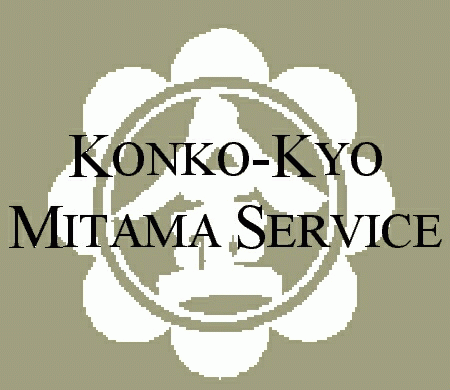 Matthew Ropp
MR520, Folk Religion
Dr. R. Daniel Shaw, Spring 1997
Fuller Theological Seminary, School of World Mission
Matthew Ropp
MR520, Folk Religion
Dr. R. Daniel Shaw, Spring 1997
Fuller Theological Seminary, School of World Mission
Table of Contents
Table of Contents
Introduction to Konko-kyo
Field Experience
Time, Space, and Participants
Visual Symbols
Ceremony, Ritual, and Prayer
Analysis of Deep Structure
Meaning
Various Symbols
Sacred Mitama Invocation and Tamagushi
Ceremony
Role of the Minister
Purpose of the Mitama Service
and the Konko Church
Missiological Implications
Notes
References Cited
Appendix - Figures
Figure 1 - Shinto
priest holdin a shaku
Figure 2 - eboshi
Figure 3 - tamagushi
Figure 4 - gohei
Figure 5 - food and drink
offerings on altar
Figure 6 - haraigushi
CLAP! CLAP! CLAP! CLAP! A bow. Silence.
The service continues: "Offering of the symbol of the true heart," the
minister chants in English and Japanese, taking a large tamagushi
and placing it on the first tier of the altar.
Introduction to Konko-kyo
Konko-kyo ( )
is one of the thirteen modern sects of Shinto, the indigenous "religion"
of Japan. The name "Konko-kyo" literally means "Gold Luster Teaching,"
but it is better translated something like, "The Teaching of the Glory
of the Unifying God." (Holtom 1965:257,260) The sect was founded in 1859
by Kawate Bunjiro, a middle-class farmer in present-day Okayama prefecture
(Murakami 1980:15) - a pious man with a keen sense of the spirit world.
Once during a serious illness, Kawate's brother-in-law was seized with
a spirit possession while ministering at his bedside. It was revealed to
Kawate that Konjin (
)
is one of the thirteen modern sects of Shinto, the indigenous "religion"
of Japan. The name "Konko-kyo" literally means "Gold Luster Teaching,"
but it is better translated something like, "The Teaching of the Glory
of the Unifying God." (Holtom 1965:257,260) The sect was founded in 1859
by Kawate Bunjiro, a middle-class farmer in present-day Okayama prefecture
(Murakami 1980:15) - a pious man with a keen sense of the spirit world.
Once during a serious illness, Kawate's brother-in-law was seized with
a spirit possession while ministering at his bedside. It was revealed to
Kawate that Konjin ( ), the "metal
deity of the northeast" who was generally believed to be malevolent, was
actually a benevolent god and was Tenchi Kane no Kami (
), the "metal
deity of the northeast" who was generally believed to be malevolent, was
actually a benevolent god and was Tenchi Kane no Kami ( ),
the "One True God of Heaven and Earth." Kawate was later himself possessed
by Konjin, and became a living god, taking the name Ikigami Konko Daijin
(
),
the "One True God of Heaven and Earth." Kawate was later himself possessed
by Konjin, and became a living god, taking the name Ikigami Konko Daijin
( ) (Holtom 1965:258-9; R. Smith
1974:60-61).
) (Holtom 1965:258-9; R. Smith
1974:60-61).
Konko became an official organization when established
by Kawate's followers in 1885, two years after his death (R. Smith 1974:61).
Because of government persecution, Konko became officially associated with
Shinto before 1900 while it simultaneously spread throughout Japan as "a
faith of this-worldly benefits, such as faith-healing and success in business."
(Murakami 1980:45,49) In actuality, Konko is in many ways divorced from
Shinto and many of the similarities that do exist are attributed to the
forced association with official Shinto in order to survive. It has repudiated
much of the body of popular magic and traditional superstitions of Japanese
folk religion found in Shinto (Holtom 1965). According to the HarperCollins
Dictionary of Religion, Konko-kyo claimed about 500,000 members in
1995 (J. Smith 1995:637).
(return to Table of Contents)
Field Experience
On May 18, 1997 I visited the Konko Church of Los Angeles
and attended the "May 18, 1997 Mitama Service" as a participant observer.
Afterwards I spoke with several of the church members and the minister
over a bowl of noodles and other refreshments.
Time, Space, and Participants
The mitama service takes place monthly in addition to
other memorial services and special calendrical based services. The service
was held on a Sunday morning at ten, taking a little longer than one hour.
The Konko Church of Los Angeles meets in a fairly small building which
is basically Western in its architectural style - the notable exception
being East Asian style decorations at the end of the eves. The sanctuary1
occupies one complete wing of the building. Located at the front of the
sanctuary is a raised platform extending back ten to fifteen feet. This
platform is separated from the rest of the sanctuary by a frame which runs
along the floor and ceiling and provides a door to enter the platform on
the left and a windowed booth on the right. In front of the platform two
groups of chairs face the platform in short rows, separated by a center
isle. Each chair had a bilingual Konko-kyo prayer book.
Those in attendance were almost exclusively Japanese2
and primarily fifty to sixty years of age or older. They sat in the chairs,
casually dressed, not separated by gender. I was greeted by a few people
and took a seat part way back. The minister entered dressed in a white
kimono typical of a Shinto
priest and a pointed white cap (eboshi).
In the fold of his kimono he kept a tapering wooden slab called a shaku3
(Ono 1962:45) which he removed and held at various times. Only the minister
entered the platform, from which he conducted the entire service. One younger
man did assist the minister during the tamagushi
ceremony and the congregation also approached (but did not ascend) the
platform.
(return to Table of Contents)
Visual Symbols
The platform was replete with symbols, many of which
I had no opportunity to explore from an emic perspective, but I will describe
the most prominent ones. The main feature is the two large multi-tiered
wooden altars at the rear
of the stage, one in the center and one to the left side. Each altar
contained many objects, including multiple food (primarily fruit and vegetables)
and drink offerings on small wooden stands, gohei,
tamagushi, and a smaller altar.
The center altar was framed by two large plant "pillars" with red and white
ribbon. Also next to the center altar was a large bag of rice and on the
second tier of the altar was a large stack of papers (perhaps the teachings
of the founder). The left altar was slightly smaller than the center one
but contained more food offerings. It had two candles on the lower tier.
On the left wall of the stage was a small table with a wooden bust of the
founder. On several golden placards decorating small tables, the platform
frame, and a pulpit used later in the service was a symbol containing the
character  , "kon" from
Konko.
, "kon" from
Konko.
(return to Table of Contents)
Ceremony, Ritual, and Prayer4
The service was composed of ceremony and ritual performed
by the minister, one ceremony in which the congregation actively participated,
and many prayers from the prayer book in both Japanese and English. The
prayers were of three types: the minister alone, antiphonal, and in unison.
Prayers in Japanese were chanted in a rhythmic style while English prayers
were read in a normal voice. The ritual and prayers were often separated
by "four solemn claps" as described at the beginning of the paper. The
order of service is described below, including the content of some of the
rituals and prayers. Words in quotes were spoken by the minister.
|
Focus On Center (Tenchi Kane no Kami) Altar
|
|
|
Mediation Prayer
|
Purification Prayer
|
purification rite - the minister shook a purification wand
(haraigushi) towards the bowing
congregation, chanting "Thank you. Thank you"
|
Kami (God) prayer - asking for mitama power for ancestors
and predecessors; divine favor depends on the sincerity of our hearts;
[minister bowed repeatedly to center altar]
|
four claps
|
"Offering of the symbol of a true heart": tamagushi
placed on the first tier of the altar
|
Japanese prayer5
|
Adoration prayer
|
divine praise prayer
|
|
Focus On Left (Mitama) Altar
|
four claps - "solemn acknowledgment"
|
"Procession to mitama altar by officiate"; lights candles
|
four claps - "solemn greetings"
|
Mitama prayer - to spirits of those before us; you had life
and lived faithfully; we honor and remember you; through working of Kami
and the Konko faith you amassed great merit; we revere you and ask for
favor and help in fulfilling tasks; protect us; give us faith, peace, prosperity,
and good homes
|
"Sacred mitama invocation and names for the month of May"
ritual - minister bows before altar and prays; he sits up; "let us pray,"
leads to a more formal, chanted prayer; reading of the (personal) names
of many mitama for several minutes; he stands and reading a prayer or teaching
from a large white paper; as each mitama name is called, prayer that they
will come into our lives to do good works in this world; pray for comfort
for each mitama; pray to the Principal Parent of the Universe.6
|
four claps
|
short ritual involving the bust of the founder
|
"Offering of the symbol of a true heart": tamagushi
placed on the first tier of the altar
|
four claps
|
Tamagushi ritual
- the entire congregation approaches the platform; each person takes a
tamagushi and places it on a table
with the top side of the branch up and the stem facing the mitama altar;
clap twice; bow and pray to whatever mitama one desires; return to seat
|
ancestor praise prayer
|
Ancestral prayer
|
four claps
|
|
Focus Changes to Teaching
|
minister moves a pulpit to the front center of the platform
|
reading of "teaching by the founder - teaching number sixty-one"
|
short sermon or teaching: we face many problems in life as
children and as adults; sometimes they even lead to unexpected death; example
of someone who had lost two children but not held a mitama service for
them - a fortune teller saw the children "sitting" on his shoulders - a
Konko minister then held a service for them; it is discourteous, offensive,
and remiss if we do not come before the Principal Parent and mitama when
there is a death; we need to give mitama thanks for the spirits (for the
death?), which will give us blessings; we will renew our spiritual lives
ever more eagerly
|
announcements
|
(return to Table of Contents)
Analysis of Deep Structure
Meaning
Literature on Konko is difficult to find and the sources
which were available spoke primarily about the group's history. Sources
relating to Shinto in general have been used to research the meanings of
many of the symbols. Except where noted the interpretations are from an
etic viewpoint. Emic viewpoints came from Aya, a woman in her seventies,
David, a young man in his twenties or thirties, and the minister, Alfred
Tsuyuki Sensei.
Various Symbols
Altars seem to be a temporary dwelling place of the
Kami or mitama spirits, the center altar in Konko dedicated to Tenchi Kane
no Kami and the left altar to the mitama, as is evidenced by the shift
of focus in the service shown above. The various items on the altar are
primarily offerings to the spirit(s) of that altar, whether food and drink
offerings or symbolic offerings such as the gohei
and tamagushi. The gohei
is both a symbolic offering (dating back to the time when cloth was actually
given as an offering) and a symbol of the presence of the Kami. The lighting
of the candles on the mitama altar symbolizes their presence. The plurality
of the food offerings on the left altar is likely due to the many mitama
represented there while only the Kami is enshrined in the center altar.
Tamagushi are discussed in detail
below. The white kimono and cap worn by the minister are symbolic of purity
by their color. It is noteworthy that the multiple paper strands hanging
from the haraigushi purification
wand used in the purification ceremony are also white. The minister's shaku
is a "symbol of the office of priest and is believed to lend dignity to
his appearance." (Ono 1962:24,44-45,52-54)
The two plant pillars with red and white ribbon are
not discussed in the literature. Their meaning might be inferred from that
of other symbols however. The green leaves may represent freshness and
life (as in the tamagushi) and
red and white indicate the sun and the moon (Ono 1962). One symbol discussed
from an emic viewpoint were the occurrences of the  symbol. Neither David or Aya associated anything particular with this symbol.
Tsuyuki Sensei explained that the symbol is taken from the name of Konjin
and used to remind them of Kami. It also means unity - thus the English
translation of Principle Parent of the Universe as Konjin's title, a title
which also intentionally avoids possible confusion by using the term "god"
or "spirit." He said that
symbol. Neither David or Aya associated anything particular with this symbol.
Tsuyuki Sensei explained that the symbol is taken from the name of Konjin
and used to remind them of Kami. It also means unity - thus the English
translation of Principle Parent of the Universe as Konjin's title, a title
which also intentionally avoids possible confusion by using the term "god"
or "spirit." He said that  is often misinterpreted as indicating prosperity or riches, and while that
is not its true meaning, he is content to let the symbol have that connotation
in order to aid in propagation of the sect.
is often misinterpreted as indicating prosperity or riches, and while that
is not its true meaning, he is content to let the symbol have that connotation
in order to aid in propagation of the sect.
I asked both Aya and David about the four claps and
bow which are used throughout the service. David was somewhat unsure, but
thought that the purpose might be to awaken the spirits, to get the attention
of the mitama to hear one's prayers.7
Here David described how he believes that everything we are - our personality,
morality, and beliefs - and our actions are products of the influence of
our mitama. He described his faith as simple, teaching purity of life.
Aya saw the purpose of the four claps as focusing one's complete attention
to Kami for the prayer and bow after the claps. Aya's prayer is a prayer
of gratefulness for her health and for her independence even during her
husband's sickness.
As described above, a tamagushi
is a sprig from the sakaki tree8
with a carefully folded piece of white paper attached. David said that
the green branch and leaves indicate life and freshness, while the white
paper tassel is a symbol for purity. Tamagushi
were used at several key points in the service. At both altars the minister
offered a large branch as a "symbol of a true heart." When discussing tamagushi
after the service, Tsuyuki Sensei indicated that the sakaki tree
is used because the branches have a definite top and bottom, with all the
leaves facing one direction. In the ceremony it is essential to offer the
top of the branch to the mitama and turn the stem toward the altar, symbolic
of a heart turned toward the Kami.
(return to Table of Contents)
Sacred Mitama Invocation and Tamagushi
Ceremony
The "sacred mitama invocation" and reading of the mitama
names for the month of May and the following tamagushi
ceremony formed the core of the mitama service9.
The focus on the mitama altar itself occupies much of the service. During
the invocation, a long list of names for the month is read. Each mitama
is asked to work in the believers' lives through a long prayer. After the
offering of the large branch, the entire congregation participates in a
ceremony of offering tamagushi
to the mitama altar. The minister stressed that this offering was not "superstitious,"
so no one should feel troubled about participating.10
The format of the ceremony is described in the order of service above.
The tamagushi used in this ceremony
were quite small, one for each participant. Offering the sprig to the mitama
altar, each participant prayed to the mitama. For most participants this
seemed to be the key meaningful moment in the entire service. They appeared
reverent and focused. For some it seemed to be purely ritual.
(return to Table of Contents)
Role of the Minister
The minister in the Konko service primarily fulfills
the role of a priest. The ministers are usually called priests in the literature,
although Tsuyuki Sensei prefers the title of minister, probably a form
of contextualization for the California setting. The minister officiates
in the service, bringing the people before Kami and the mitama. The Konko
minister has many of the characteristics of a priest as described by Hiebert
and Shaw: a full time religious specialist; origins in a peasant cultural
setting (which has moved to an industrial setting); serving the people
primarily in formalized contexts. The minister also participates in shamanic
and teaching activity. He interacts with the people and their needs in
healing and funeral services and instructs them in the teaching of the
founder (Hiebert and Shaw 1993:223-227). Tsuyuki Sensei described himself
as a servant of Kami and a mediator (toritsugisha) between his congregation
and Tenchi Kane no Kami. His sermon was focused on encouragement to seek
him and the Konko services as such a mediator. Konko does teach that believers
can pray to the mitama directly, however (Akedo "e_page002.html").
(return to Table of Contents)
Purpose of the Mitama Service
and the Konko Church
What needs does the mitama service and Konko-kyo in
general meet for its participants and adherents? These are key questions.
The answers draw together the focus of the many symbols, prayers, and ceremonies
discussed above. Konko meets the needs of the family when there is a death
(providing meaning and purpose through that loss as the deceased becomes
a mitama), it encourages the people to live a pure life, to seek the blessings
of Kami and the mitama, and it promises them prosperity and happiness.
According to various sources, physical healing is also a key part of Konko.
Holtom's chapter on Konko is titled "The Faith-Healing Sects: Konko-Kyo."
(Holtom 1965) Nonetheless, this had no place in the mitama service I attended.
Of key importance are the simple instructions and
guidance for daily living, manifest in David's comments above, and pervasive
in the teaching of the founder. "Don't burden others with your troubles.
Pray to God wherever you are. Remember to live a quiet life. It is better
to strike your own head than that of your child… Never accept your defeat
even for a moment. Forgive the wrath of others. God recognizes open-mindedness
and gives blessings. Pray to God. God makes you prosper in your business."
(Akedo "epage_201.html","epage_202.html") Aya told how she grew up in a
home where there was never any violence and how that was very special to
her in a world full of violence.
When analyzed according to Hiebert's analytical model,
these people certainly understand the middle zone. They are in touch with
mitama spirits who live in this zone and affect their lives. They also
relate to the top zone, with their concept of Tenchi Kane no Kami, a basically
monotheistic "high God" view. They exhibit both organic and mechanical
religious behavior. They pray directly to the mitama and the Kami, thanking
them for various things and interacting with them. Much of their service
is very ritualized and mechanical however - four claps to get the spirits'
attention; chanted liturgical prayers.
(return to Table of Contents)
Missiological Implications
From a brief study of the Konko sect and the mitama
service, what are the missiological implications for working with Japanese
people? It is evident that Konko fits nicely with a traditional Japanese
worldview. There is emphasis on the ancestors, purity and simplicity, the
beauty and life of nature, group unity, and symbolic offerings and prayer
to deity and spirits. Many of these things can and should be incorporated
into a Christianity that is relevant to the Japanese people. Care can be
taken to honor and learn from our ancestors (not as spirits but as those
who came before) while not worshipping them. Offerings, rites, and symbols
meaningful to the Japanese consciousness can be incorporated into Christian
liturgical contexts. Emphasis can be put on unity and simplicity over Western
hyper-individualism and technical religion. The purification rite has an
analogy in Christian confession and divine forgiveness. Of course, care
must be taken to research each aspect of the process in order to avoid
problems with syncretism, especially with certain symbolic forms. Certainly
some should not be used. These are simply initial ideas based on one small
case study, but I believe that many things can be done in this area - speaking
to the Japanese heart without compromising the gospel. Personally I would
like to continue my study of religious anthropology, focusing on Shinto,
Buddhism, and folk religion (the three are not exclusive!) in the Japanese
context.
(return to Table of Contents)
Notes
1 I use "sanctuary" for ignorance of a
better term. "Worship hall" does not seem appropriate…
2 The one exception (other than myself)
appeared to be the husband of a Japanese woman.
3 See the appendix for a sketch of
these and many of the other items.
4 I have not followed Hiebert and Shaw’s
distinction of "ritual" and "ceremony" herein. Semantically at least,
it is difficult for me to make the distinction. In general, I have
used the words somewhat interchangeably, although I have tried to limit
ceremony to group activity and right to more individual activity.
Following Hiebert and Shaw, the entire service is probably ceremony only
– it is cyclical and group oriented. Within the service, however,
the priest performs various individual rites, which I prefer to see as
ritual. They are not, however, critically motivated.
5 This indicates a prayer for which
I cannot translate the title. Underlined words are rough translations
of the Japanese prayer title. I believe many, but not all, of the
Japanese prayers were analogous to the English prayers immediately preceding
or following them.
6 English translation used by the minister
for Konjin’s title of Tenchi Kane no Kami.
7 A common East Asian religious practice.
Four claps seems strange, though, as the number is often associated with
death. Perhaps this is an implicit repudiation of common superstition.
8 Huckleberry branches are used here
in California. It has similar features to the unavailable sakaki.
9 Perhaps these two parts of the service
are not separated, but seen as a whole from the emic viewpoint.
10 It was important to them that I
as a participant/observer in the service (even as a non-member and a Christian)
participate in this ceremony with them. This as well as Tsuyuki Sensei’s
extreme openness to me were remarkable.
(return to Table of Contents)
References Cited
Akedo, Masayuki
"The Way of God." A Page of KONKO-KYO YAMASAKI
mission
 .
http://www2g.meshnet.or.jp/~akechan/e_page000.html.
.
http://www2g.meshnet.or.jp/~akechan/e_page000.html.
Hiebert, Paul G. and R. Daniel Shaw
1993 The Power and the Glory. Unpublished
manuscript. Pasadena, California.
Holtom, D. C.
1965 The National Faith of Japan. New
York: Paragon Book Reprint.
Murakami, Shigeyoshi
1980 Japanese Religion in the Modern Century.
H. Byron Earhart, trans. Tokyo: University of Tokyo Press.
(Original: Nihon Hyakunen No Shukyo. Kodansha, 1968.)
Ono, Sokyo
1962 Shinto: The Kami Way. Tokyo: Charles
E. Tuttle.
Smith, Jonathan Z., ed.
1995 The HarperCollins Dictionary of Religion.
San Francisco: HarperSanFrancisco.
Smith, Robert J.
1974 Ancestor Worship in Contemporary Japan.
Stanford, California: Stanford University Press.
(return to Table of Contents)
Appendix - Figures
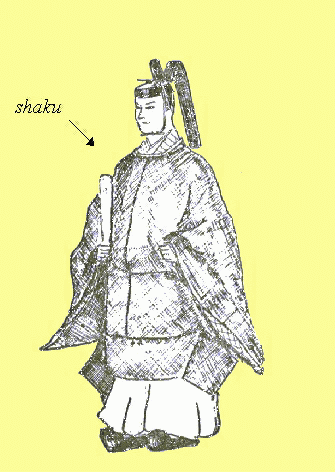 Figure 1 - Shinto priest holdin a shaku
Figure 1 - Shinto priest holdin a shaku
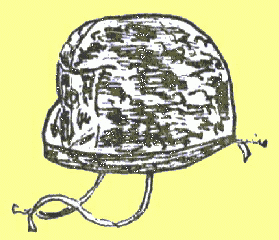 Figure 2 - eboshi
Figure 2 - eboshi
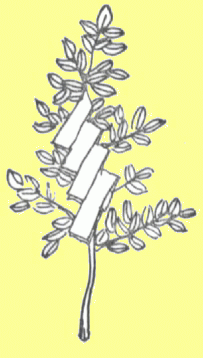 Figure 3 - tamagushi
Figure 3 - tamagushi
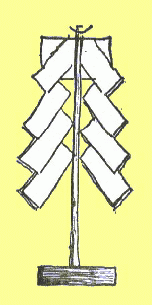 Figure 4 - gohei
Figure 4 - gohei
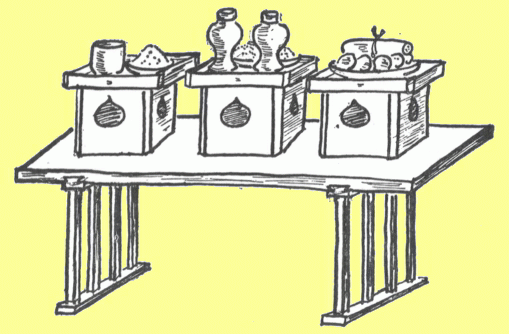 Figure 5 - food and drink offerings on altar
Figure 5 - food and drink offerings on altar
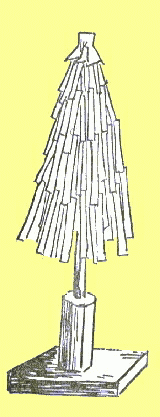 Figure 6 - haraigushi
Figure 6 - haraigushi
Return to Table of Contents
Return to paper index
home


![]() symbol. Neither David or Aya associated anything particular with this symbol.
Tsuyuki Sensei explained that the symbol is taken from the name of Konjin
and used to remind them of Kami. It also means unity - thus the English
translation of Principle Parent of the Universe as Konjin's title, a title
which also intentionally avoids possible confusion by using the term "god"
or "spirit." He said that
symbol. Neither David or Aya associated anything particular with this symbol.
Tsuyuki Sensei explained that the symbol is taken from the name of Konjin
and used to remind them of Kami. It also means unity - thus the English
translation of Principle Parent of the Universe as Konjin's title, a title
which also intentionally avoids possible confusion by using the term "god"
or "spirit." He said that ![]() is often misinterpreted as indicating prosperity or riches, and while that
is not its true meaning, he is content to let the symbol have that connotation
in order to aid in propagation of the sect.
is often misinterpreted as indicating prosperity or riches, and while that
is not its true meaning, he is content to let the symbol have that connotation
in order to aid in propagation of the sect.





